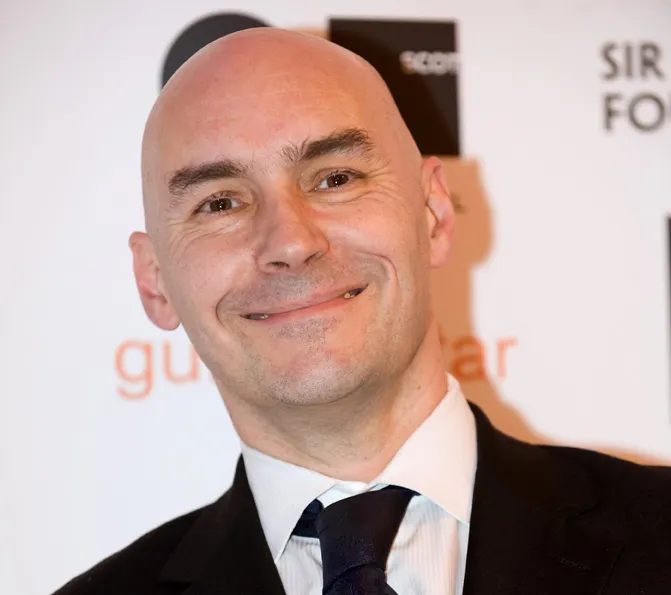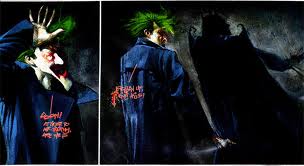
Note: I am reprinting, without change, a series on Grant Morrison’s Batman work originally printed in 2013 on my old site.
I don’t love everything Grant Morrison does. But I respect it. I used to find him horribly obtuse and confusing. I still feel that way about most of Final Crisis. And my first real introduction to his work on Batman was with Batman R.I.P. Not a good place to start, because that’s really the middle of a long-form story. So, five years ago, when I created the blog post tag “Grant Morrison Sucks,” I meant it. But as I’ve followed him through Batman and Robin and into Batman, Inc., I’ve become a true believer. When he killed Damian Wayne, it all made sense. The entire journey.
DC did take much of the suspense and power out of the story by rebooting its entire line and making Batman’s canon worse by allowing Morrison to continue his story in a new universe where it really doesn’t make sense. So I try to read Morrison’s Batman as entirely self-contained. It just works better that way. Everyone else who plays with the toys he created, or in many cases the caricatures that he gave dimension and meaning to, can do what they like. That’s not part of Morrison Canon. At least not to me.

Recently, I decided to re-read the entire thing—all the GM Batman—in light of the end of Morrison’s work on Batman (and, it turns out, his work with DC overall). And I’ve come to the conclusion that it is one of the greatest comic book stories of all time—if not THE greatest. Beautiful art and tons of Easter Eggs reward rereads—which are essential to a collector-based industry—and the story all comes to full conclusion. No loose ends. Every shotgun on the mantle gets fired, every clue had meaning—unless he didn’t want it to on purpose.

I could also call this multi-part post, “The only Batman saga you’ll ever need to read.“ This is not to say that there aren’t many other great takes on this character, whether you prefer the nonstop action of “No Man’s Land;” Frank Miller’s dystopian “The Dark Knight Returns” (and his arguably even better “Batman: Year One”); the more jokey, accessible Batman by Mike Barr and Jim Aparo of the early 1980s; or the various great Robin stories, Joker stories, and all the other myriad ways in which Batman has been characterized and re-purposed over the decades. But Grant Morrison is the only writer to have a complete vision of not just Batman but the entire Gothamverse, with Batman as its “big bang.” He’s the only one who has tried to make sense of it all: All the different personalities represented throughout the many arcs of Batman, the Manga versions, the silliness (Bat Mite!), the ultra-seriousness, the soap-opera nature of serialized comic books…In fact, you could say that it is for that very reason that Morrison’s Batman became a fragmented person, first by slowly losing his mind and then by losing his very body throughout the timestream after his “death” at the hands of Darkseid. It’s easily the most re-readable, deep, thoughtful comic book epic ever created, and it’s truly the only one you’ll ever “need” to read.
So, with all of that introduction behind us, let’s start today with Morrison’s first Bat-book.

ARKHAM ASYLUM
Many of those who write and/or read Grant Morrison’s Batman work don’t start as far back as 1989, but the purpose of this extended article is to analyze all of the pieces of Morrison’s mosaic, so I will.
Morrison’s very first work on Batman was, ironically, probably his most controversial and experimental, his least accessible and worst reviewed. In 1989, he teamed up with artist Dave McKean to create the original graphic novel titled “Arkham Asylum: A Serious House on Serious Earth.” Right from the title, which is a quote from a relatively unknown poet, Morrison begins his encyclopedic approach to Batman, weaving in esoteria and linking to things that only the most astute, research-oriented readers will appreciate. All of his work can be read this way, on two levels: For the story, and for the subtext. But with Batman in particular, the subtext can often become intrusive and dominating. I hated Grant Morrison’s Batman when I first was exposed to it, because I started with Batman: R.I.P., which is virtually impossible to understand unless you’ve read the foundation underlying it.

The story of Arkham Asylum is deceptively simple: Arkham Asylum, the D.C. Universe’s holding pen for Batman’s rogues gallery, has been overtaken by the inmates—led by Joker—and Batman has to go in and restore order. It gives Morrison the chance to write about all of Batman’s major villains, as well as to tell a story within specific confines: Arkham’s walls. Some of Morrison’s best tales take place in claustrophobic settings like this.
But the art reveals the complexities here. Even the lettering is experimental, almost stream-of-consciousness, and many who read it find this book impenetrable. It definitely takes work to follow as Morrison becomes increasingly insane. Yes, that’s the irony: He breaks into a mental ward and, in so doing, is driven to the brink of sanity. The books is difficult, arcane, and complex, but rewarding to careful, repeat readers. It’s emblematic of Morrison’s later work with the character, even if this story doesn’t “fit” in his main Batman epic.
It also presages Morrison’s fascination with Batman on drugs. Almost all of the “major” Batman epic storylines feature prominent or subtle drug use, usually hallucinogenic drugs.
GOTHIC

And then there’s “Gothic.” An early story arc in the Batman anthology series “Legends of the Dark Knight,” a title intent on bringing in new perspectives on Batman, and/or retconning parts of the character’s universe. Gothic featured artwork by the legendary Klaus Janson. But he wasn’t totally legendary at the time. And Morrison wasn’t The Grant Morrison yet.
Gothic is sort of a crime noir take on Nightmare on Elm Street. Gotham City’s biggest mobsters are getting killed off by a guy named Mr. Whisper—who those same mobsters “killed” many years ago because Mr. Whisper was a child killer. The story discusses Bruce Wayne’s childhood, showing that although his parents were good to him, his private schooling was less than idyllic. It is intensely dark, and its focus on fatherhood and childhood are common themes for Morrison’s Batman work.
These two early works can be thought of as preparation. They aren’t essential reading, they’re really for hardcore fans mostly, but they reveal a lot about what’s to come.
Next: The main event begins with Batman & Son.

